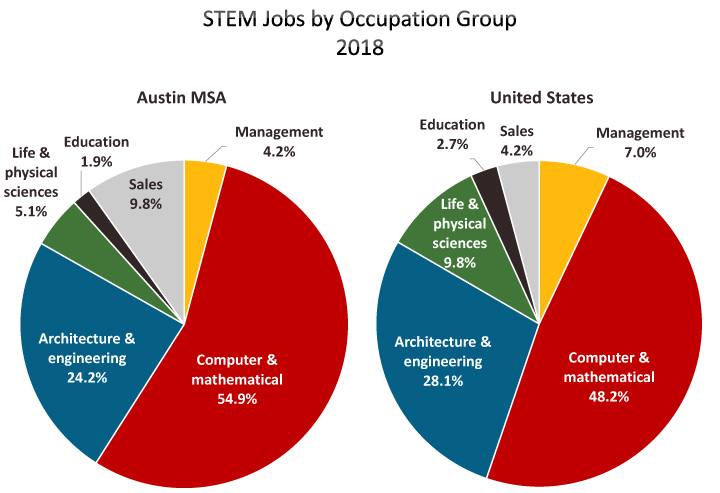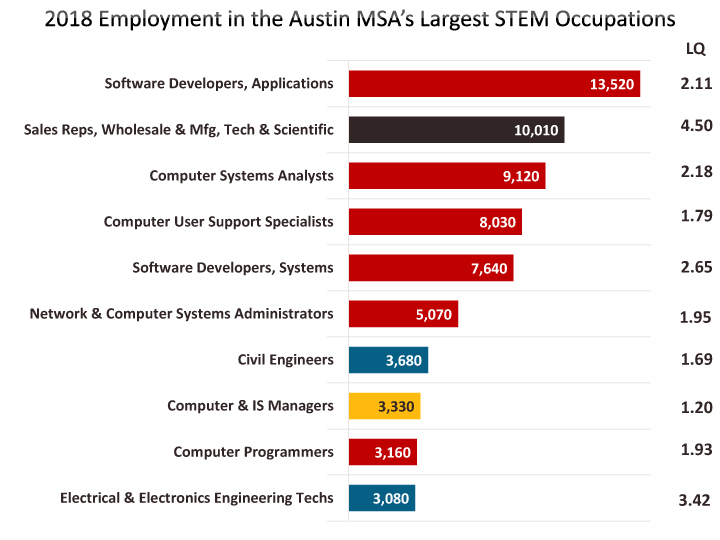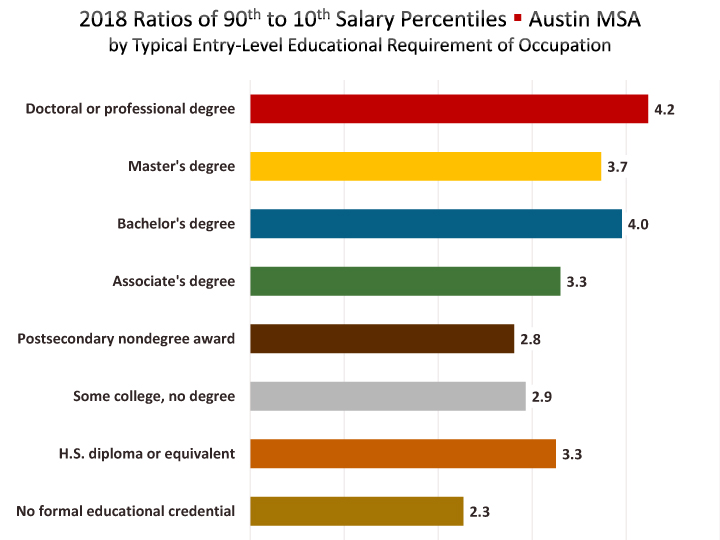Occupational Employment & Salaries: STEM & Educational Qualifications
Posted on 04/09/2019 by Beverly Kerr
- STEM occupations account for 11.1% of all jobs in the Austin MSA in 2018, making Austin the 6th most concentrated in STEM among large U.S. metros.
- Austin’s two largest STEM occupations are applications software developers (13,520 jobs) and sales representatives for technical and scientific products (10,010).
- Over 26% of all jobs in the Austin MSA are in occupations with a bachelor’s degree as the typical entry-level education requirement.
- The median salary of jobs requiring a bachelor’s degree is twice that of a job requiring a high school diploma, both nationally and in Austin.
New data released by the U.S. Bureau of Labor Statistics (BLS) on March 29th provides estimates of 2018 employment and salaries by occupation. Estimates from the Occupational Employment Statistics (OES) program are available for the nation as a whole and for over 500 other areas.
Across all occupations, Austin’s average annual salary is $53,810 and its median salary is $40,070. The average hourly wage is $25.87 and the median is $19.26 in the Austin metro. Austin’s average salary is 3.6% above the national average and the median is 3.7% above the national median. Salaries in Austin are about 2% higher (average and median) than in Dallas-Fort Worth and 15% (average) or 14% (median) higher than San Antonio. Compared to Houston, Austin’s average salary is about 1% lower and the median about 1% higher.
Part of the differences in average wages and salaries between different areas is due to variation in the mix of occupations prevalent in each area. Over 800 occupations are covered in the OES survey, with over 600 of those available for the Austin MSA. The OES survey is sent to hundreds of Austin-area employers every May and November and is vital as the foundational data needed to quantify pay and employment for occupations.
Associated with the survey are a pair of supplementary sets of OES data treating science, technology, engineering and math (STEM) occupations and occupations by the typical entry-level educational requirement. The following focuses on insights from those two tabulations.
STEM Occupations
BLS classifies 100 occupations as STEM, including computer and mathematical, architecture and engineering, and life and physical science occupations, as well as managerial and postsecondary teaching occupations related to these functional areas, and sales occupations requiring scientific or technical knowledge at the postsecondary level.

In 2018, there were an estimated 113,700 STEM jobs in the Austin metro, representing 11.1% of total employment. Nationally, STEM jobs account for 6.3% of employment. Among the 50 largest metros, Austin ranks sixth for percentage of jobs in STEM occupations. San Jose tops the major metros ranking with 21.0% in STEM. Las Vegas and Riverside have the lowest employment shares, both 2.9%.

Texas has the same rate of STEM employment, 6.3%, as the nation. The range among the major Texas metros is wide. Houston’s percentage is 7.3% (19th), Dallas-Fort Worth is 7.2% (ranking 22nd), while San Antonio is 5.0% (ranking 45th).

Across major metros, higher shares of STEM employment are associated with higher average salaries overall.

In Austin, STEM occupations earn a median annual salary of $88,820 compared to $37,030 for non-STEM occupations. Nationally, STEM’s median salary is $84,880 compared to $37,020 for non-STEM. The median STEM salary in Austin is 240% of the non-STEM salary. Nationally, the median STEM salary is 229% of the non-STEM salary. STEM salaries are highest in San Jose, which has a median of $123,210, which is 252% of San Jose’s $48,920 non-STEM salary.

The two highest paid STEM occupations, nationally and in Austin, are architectural and engineering managers and computer and information systems managers. In Austin, architectural and engineering managers have a median salary of $152,560, which is 8.4% above the national median of $140,760; and computer and IS managers have a median salary of $145,420, which is just 2.0% above the national median of $142,530. Compared to San Jose, where these two occupations are much more concentrated, Austin architectural and engineering managers earn a median salary that is 16.4% less, and computer and IS managers earn 23.1% less, than they do in San Jose.

Austin’s largest STEM occupation is applications software developers, which are estimated at 13,520 jobs. As the graph above indicates, this occupation has a location quotient (LQ) in Austin of 2.11.

Location quotients are a useful byproduct of the survey’s employment estimates. The location quotient (LQ) represents the ratio of an occupation’s share of employment in a given area to that occupation’s share of employment in the U.S. as a whole. In this case, application software developers make up 1.3% of employment in Austin compared with 0.6% of U.S. employment. Austin’s 1.3% rate is 2.11 times 0.6%, therefore Austin’s LQ for the occupation is 2.11.

The next largest STEM occupation in Austin is wholesale and manufacturing sales representatives for technical and scientific products. There are 10,010 of these, the occupation has an LQ of 4.50, and no metro has a higher LC for this occupation. This occupation may be one signal of some of the differences between Austin’s and San Jose’s tech sectors. This sales occupation is also in San Jose’s STEM top 10, but there are actually fewer in San Jose (7,720) than Austin, and the San Jose LQ is 3.19.

San Jose, in fact, has more jobs for computer hardware engineers (8,450) which has a remarkable LQ of 17.99. Electronics engineers, except computer, is also a top 10 occupation in San Jose (6,040 jobs and an LQ of 5.83). In Austin, electronics engineers, except computer (3,030 jobs) has an LQ of 3.18, and computer hardware engineers (400 jobs) has an LQ of only 0.92 (i.e., the occupation is slightly less prevalent here than it is nationally).[1]




Occupations by Education/Training
Each occupation in the OES survey is associated with a typical entry-level educational/training requirement, ranging from “no formal educational credential” to “doctoral or professional degree.”

In Austin 270,170 jobs, or 26.3%, require a bachelor’s degree. Nationally, 21.7% of jobs require a bachelor’s degree. Austin’s 26.3% rate ranks as the seventh highest among the 50 largest U.S. metro areas.

Occupations requiring a master’s, doctoral, or professional degree (41,680) are less concentrated in Austin (4.1%) than nationally (4.4%). Among large metros, Austin ranks 29th for the percent of jobs requiring a graduate degree.
Jobs requiring a bachelor’s degree or higher account for 30.3%[2]of jobs in Austin and Austin ranks 10th for the percent of jobs in occupations requiring at least a bachelor’s degree as the typical entry-level educational requirement.

The median salary of a job requiring a bachelor’s degree is twice that of a job requiring a high school diploma, both nationally and in Austin.

In Austin, the highest paid 10% of workers (those at or above the 90th percentile) earned about five times as much as the lowest paid 10% (the 10th percentile). When jobs are grouped by educational requirement, the differential between the top 10% and the bottom 10% increases with education. The top 10% of jobs with no formal educational credential only pay about twice as much as the bottom 10%; among workers in jobs requiring a high school diploma, the highest paid 10% earn about three times the lowest paid 10%; and among workers in jobs requiring a bachelor’s degree, the highest paid 10% earn four times the lowest paid 10%.






FOOTNOTES
[1] It should be noted, when relying on employment estimates for individual occupations like these, that all estimates are subject to the survey’s sampling error and BLS publishes relative standard error (RSE) statistics for each employment estimate. The RSE is defined as the ratio of the standard error to the survey estimate. For example, a RSE of 10% implies that the standard error is one-tenth as large as the survey estimate. Austin’s total STEM employment estimate (113,700) has a relative standard error (RSE) of 1.6. Electronics engineers, except computer, are estimated at 3,030 in 2018, but the RSE is 21.7.
[2] Note that occupations are associated with a typical entry-level educational requirement. In practice, a range of levels of educational attainment may be prevalent in an occupation. The share of workers in Austin with a bachelor’s degree or higher is greater than the 30.3% share of jobs requiring this level of education. According to the Census Bureau’s American Community Survey, 48.4% of employed workers between 25 and 64 years have a bachelor’s degree or higher. About 16% of the civilian employed are outside this age range, so the actual percent of workers with a bachelor’s degree or higher isn’t estimated.